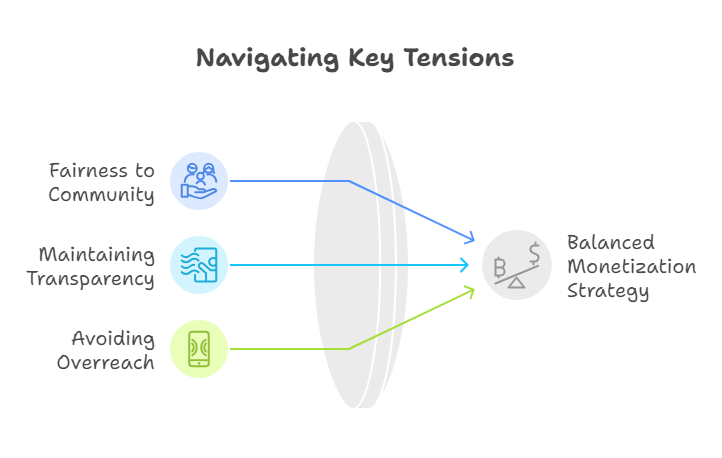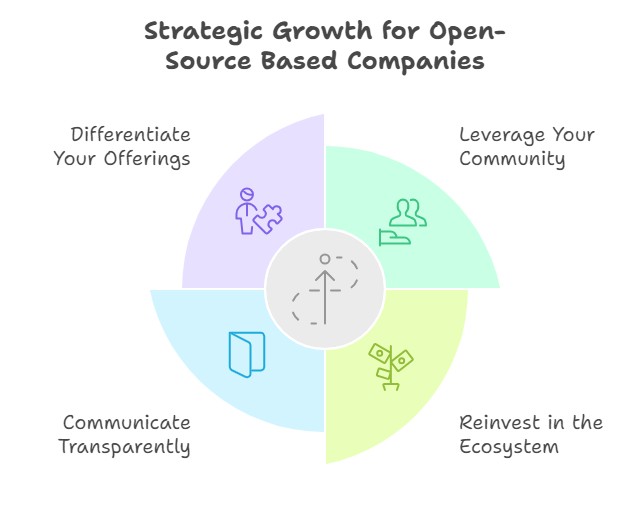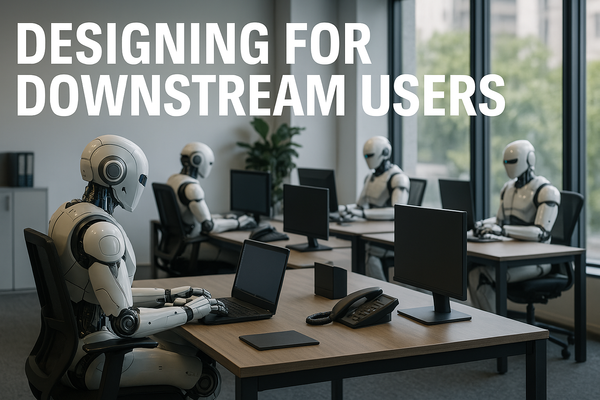Balancing Open-Source Values with Commercial Growth

Working at Rackspace Technology has given me a front-row seat to the intricate dance between open-source principles and commercial viability. Our journey with OpenStack has been one of balancing transparency and innovation while finding ways to differentiate and monetize responsibly. At Rackspace, we’ve leaned into the Red Hat playbook—offering everything open-source, from code to runbooks and documentation, while differentiating through enterprise-grade stability and hosting-specific features. It’s a journey that has taught me just how critical trust is when building a business rooted in open-source values.
It's this context that underpins the conversation today and why the story of Anaconda drove me to write this post. Moving into the world of data science, few tools have had the transformative impact of Anaconda. Founded in 2012 by Travis Oliphant and Peter Wang, Anaconda emerged as the solution to a problem every data scientist at the time was facing: dependency conflicts and time-consuming library installations. Before Anaconda, setting up an environment meant piecing together tools like NumPy, Pandas, and Matplotlib manually—a process fraught with frustration and inefficiency. Anaconda changed that by offering an integrated distribution managed by its robust Conda package manager. It was a breakthrough that didn’t just streamline workflows; it elevated productivity for an entire community.
Today, over 30 million users rely on Anaconda, from students dipping their toes into data science to enterprise teams solving complex AI challenges. Anaconda isn’t just a product; it’s an ecosystem, a movement, and a trusted partner to countless professionals. Yet its journey—from open-source innovator to enterprise powerhouse—has been marked by one of the most delicate balancing acts in tech: maintaining the trust and goodwill of an open-source community while building a sustainable, commercially successful business.
Today I would like to take you through Anaconda’s journey, offering lessons for product leaders navigating similar challenges. First, we’ll explore how Anaconda built its loyal following, analyzing the principles and strategies that made it a cornerstone of the data science community. From there, we’ll examine how the company has grown that trust into a robust commercial engine, leveraging its community-driven roots while addressing enterprise needs. Finally, we’ll confront the challenges ahead: how Anaconda—and companies like it—can continue to grow without alienating the very user base that brought them success.
By the end of this piece, you’ll not only understand Anaconda’s story but also gain actionable insights into balancing open-source values with commercial objectives, navigating tensions between community trust and monetization, and setting the stage for sustainable growth. Let’s dive in.
The Foundation of Trust: Building a Loyal Following
Anaconda’s success didn’t happen by chance. It began with a relentless focus on solving real user pain points. By bundling essential tools into a single, reliable distribution, Anaconda eliminated the hassle of managing dependencies and environments—a common source of frustration for developers and data scientists.
But beyond technical innovation, Anaconda has always emphasized community engagement. From supporting foundational libraries like NumPy and Pandas to fostering collaboration through its Nucleus community, the company has invested heavily in the ecosystem it serves. These actions build goodwill and reinforce trust, positioning Anaconda within the community not as a corporation but as a steward of the data science community.
With a strong foundation of trust and a user base that spans academia, startups, and enterprises, the next question for Anaconda was how to grow without betraying its open-source roots.
Navigating Growth: The Balance Between Open Source and Enterprise
Scaling an open-source project into a profitable business is no small feat. Anaconda faced the classic open-source tension: How do you monetize a free product without alienating the community that made it successful?
Anaconda’s solution was to delineate clearly between its free and paid offerings. While the Anaconda Distribution remains free and open-source, enterprise customers gain access to additional features like role-based access controls, secure repositories, and compliance tools. This strategy respects the open-source ethos while addressing the specific needs of enterprise users who are willing to pay for enhanced capabilities.
Why It Works: Enterprises value reliability, security, and governance—areas where Anaconda delivers significant value. For example, in a world increasingly focused on software supply chain security, Anaconda’s enterprise offerings provide vulnerability scanning and license management, reducing risk and ensuring compliance. These are features that an open-source enthusiast might not need but are critical for large-scale operations.
As Anaconda expanded its enterprise reach, the tension grew, and the challenge shifted to “how can we grow this ecosystem without eroding the trust of our foundational users.”
Turning Community Trust into Strategic Advantage
Anaconda’s community isn’t just a user base; it’s a strategic asset. The developers, educators, and data scientists who rely on Anaconda don’t just use the tools—they advocate for them and contribute to them. This advocacy stems from a shared sense of ownership, fostered by Anaconda’s open-source principles and transparent communication.
One of the company’s most effective strategies has been reinvesting in the ecosystem. Anaconda contributes to key projects like NumPy and Pandas, supports open-source standards, and actively participates in community governance. These actions signal that Anaconda isn’t just profiting from the ecosystem but actively working to sustain it.
Example in Practice: Imagine a university professor introducing students to data science using the free Anaconda Distribution. Those students, once in the workforce, often advocate for Anaconda’s enterprise solutions because they trust the brand and understand its value. This cycle of advocacy underscores the importance of nurturing your community—not simply as a market to monetize but as partners in a shared mission.
While community trust fuels growth, it also places limits on how aggressively a company can monetize. Anaconda’s next challenge lies in navigating this delicate balance.
The Challenges Ahead: Balancing Monetization and Open-Source Values
As Anaconda grows, it must confront an uncomfortable truth: the strategies that drive commercial success can sometimes conflict with open-source principles. For instance, while enterprises are willing to pay for advanced features, there’s always the risk that these offerings could be perceived as locking valuable capabilities behind a paywall.

Key Tensions:
- Fairness to the Community: Open-source users may feel alienated if commercial features seem like a natural extension of the free product rather than distinct, enterprise-focused capabilities.
- Maintaining Transparency: Clear communication is essential to ensuring users understand what’s free, what’s paid, and why.
- Avoiding Overreach: Over-monetization risks eroding the goodwill that underpins the brand. Monetization needs to feel fair, which not only means having a unique understanding of your communities’ thoughts but a strategy to help influence those thoughts as well.
What Can Be Learned: Companies navigating similar challenges should focus on delivering measurable, defensible value in their commercial offerings. Features that enhance security, scalability, or compliance—areas critical to enterprise operations—justify premium pricing without undermining the free product’s value.
Companies should also leverage their good-will to strategically guide the narrative, being honest about the realities of the mission they’re on and the need to support it financially. If a sense of shared ownership is what built that community, as is the case with most open-source projects, then this will resonate if it’s part of a transparent effort to bring the community together and move shared goals forward.
The tension between open source and commercialization isn’t just a challenge; it’s an opportunity to redefine how companies operate in this space. How can other open-source projects learn from this to better navigate the natural tension and harness the incredible power of community?
The Path Forward: Sustaining Growth Without Losing Trust
Anaconda’s journey offers a blueprint for companies navigating the intersection of open source and enterprise. The key is to recognize that community trust and commercial success aren’t mutually exclusive—they can reinforce each other when managed thoughtfully.
Practical Strategies:
- Leverage Your Community: Use community feedback to guide product development, ensuring that both free and paid offerings address real user needs.
- Reinvest in the Ecosystem: Support foundational projects, sponsor initiatives, and contribute to standards that benefit the broader community.
- Communicate Transparently: Clearly articulate your monetization strategy, emphasizing how it aligns with your values.
- Differentiate Your Offerings: Ensure that paid features provide distinct, enterprise-grade value that complements, rather than replaces, the free product.
By embracing these strategies, Anaconda—and companies like it—can navigate the challenges of growth while staying true to their roots.

Conclusion: Building a Sustainable Future Through Balanced Innovation
Anaconda’s journey to becoming as ubiquitous in its space as Kleenex is in its space is one of balance: between innovation and tradition, community and commerce, trust and growth. As it continues to scale, the company faces the ongoing challenge of maintaining its open-source ethos while delivering value to its enterprise customers and meeting its commercial goals.
For product leaders, the lessons are clear. Building trust isn’t just about technical excellence, though that is a huge part of the equation as well; it’s about something even harder, engaging your community, truly listening to their needs, and aligning your business strategy with your values. Monetization doesn’t have to mean compromise but if you’re not careful it can become that. By delivering value that is both tangible and fair, companies can turn the tension between open source and commercialization into a source of strength.
As the data science landscape evolves, Anaconda’s journey serves as a reminder that success isn’t just about what you build—it’s about how you build it, who you bring with you and for whom you are building it for. The future belongs to those who can navigate these complexities with integrity, transparency, and vision while still capturing economic success.



